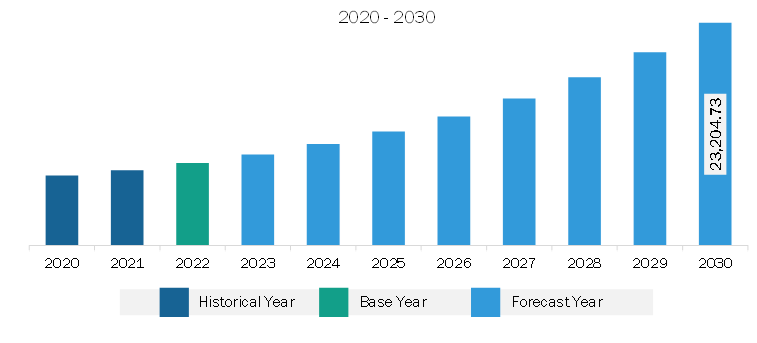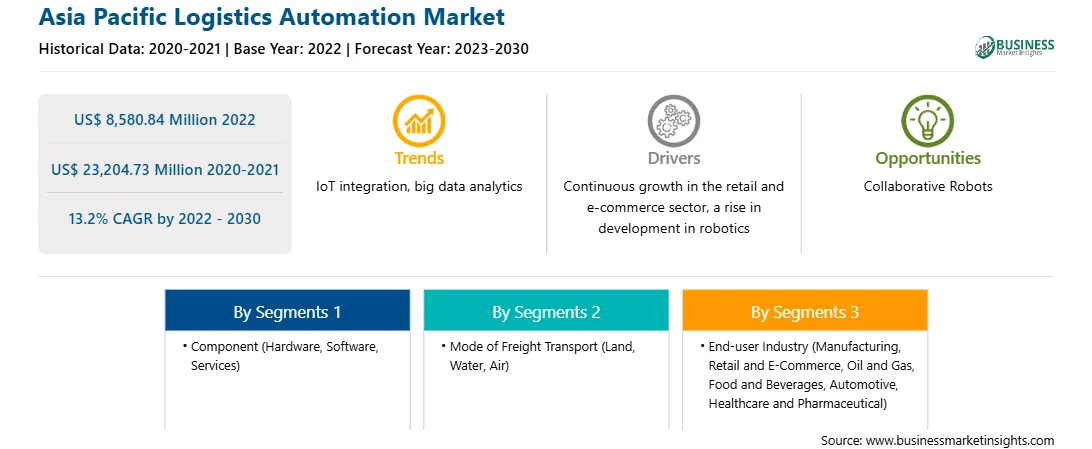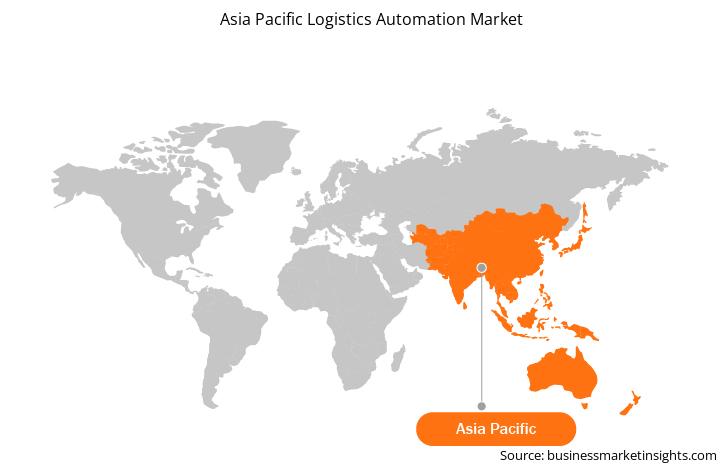The Asia Pacific logistics automation market was valued at US$ 8,580.84 million in 2022 and is expected to reach US$ 23,204.73 million by 2030; it is estimated to register at a CAGR of 13.2% from 2022 to 2030. Continuous Growth in Retail & E-commerce Sector Boost Asia Pacific Logistics Automation Market
The importance of autonomous cars in the logistics business has grown in recent years as they have increasingly been deployed in precisely controlled environments such as warehouses and yards. However, deploying autonomous vehicles in shared and public locations, such as highways and city streets, might be the industry's next great step in optimizing logistics operations and increasing safety. The expanding technological developments in AI, as well as the increasing substantial investments in the development of sensors and visual technologies, can assist in self-driving vehicles. Autonomous vehicles and drones are important components of automated logistics systems. Google and Tesla, for example, have made substantial advances in driverless vehicle technologies. Autonomous driving has progressed from science fiction to a very feasible possibility in the last two decades, owing to significant advances in radar technology and computer power. Because portable technology has improved sufficiently to allow ultra-light hardware to make decisions based on self-improving algorithms, engineers have a better chance of mimicking human decision-making in autonomous vehicles.Asia Pacific Logistics Automation Market Overview
Growing technological advancements have encouraged the adoption of robots in various industries. Logistics automation is becoming essential for retailers owing to the growing retail and e-commerce sectors worldwide. Market players are trying to achieve omnichannel and online strategies. Thus, logistics automation is necessary for retailers. Logistics automation ensures inventory management, tracking, reporting and forecasting, packaging, transportation of goods, and warehouse management. The retailers attract customers by providing free and fast delivery options. Thus, various industries are shifting toward adopting logistics automation to achieve effective supply chain processes and gain a competitive advantage to maintain their strong presence in the market. Continuous technological advancements and the rise in demand for automation positively impact the global market.
Asia Pacific is anticipated to witness the fastest growth rate over the forecast period. Rapid digitalization and developments in the economy, adequate government support, and an increase in middle-class income have ensured a smooth transition of economies in the region from the developing stage toward the developed stage. According to the Asian Development Bank, Asia is the fastest-growing region in the global e-commerce marketplace, with the largest share of the world's business-to-consumer e-commerce market. Thus, the growing e-commerce industry generates the demand for automation in the region, fueling the Asia Pacific logistics automation market.
Asia Pacific Logistics Automation Market Revenue and Forecast to 2030 (US$ Million)
Strategic insights for the Asia Pacific Logistics Automation provides data-driven analysis of the industry landscape, including current trends, key players, and regional nuances. These insights offer actionable recommendations, enabling readers to differentiate themselves from competitors by identifying untapped segments or developing unique value propositions. Leveraging data analytics, these insights help industry players anticipate the market shifts, whether investors, manufacturers, or other stakeholders. A future-oriented perspective is essential, helping stakeholders anticipate market shifts and position themselves for long-term success in this dynamic region. Ultimately, effective strategic insights empower readers to make informed decisions that drive profitability and achieve their business objectives within the market. The geographic scope of the Asia Pacific Logistics Automation refers to the specific areas in which a business operates and competes. Understanding local distinctions, such as diverse consumer preferences (e.g., demand for specific plug types or battery backup durations), varying economic conditions, and regulatory environments, is crucial for tailoring strategies to specific markets. Businesses can expand their reach by identifying underserved areas or adapting their offerings to meet local demands. A clear market focus allows for more effective resource allocation, targeted marketing campaigns, and better positioning against local competitors, ultimately driving growth in those targeted areas.
Asia Pacific Logistics Automation Strategic Insights

Asia Pacific Logistics Automation Report Scope
Report Attribute
Details
Market size in 2022
US$ 8,580.84 Million
Market Size by 2030
US$ 23,204.73 Million
Global CAGR (2022 - 2030)
13.2%
Historical Data
2020-2021
Forecast period
2023-2030
Segments Covered
By Component
By Mode of Freight Transport
By End-user Industry
Regions and Countries Covered
Asia-Pacific
Market leaders and key company profiles
Asia Pacific Logistics Automation Regional Insights

Asia Pacific Logistics Automation Market Segmentation
The Asia Pacific logistics automation market is segmented based on component, mode of freight transport, application, end-user industry, and country.
Based on component, the Asia Pacific logistics automation market is segmented into hardware, software, and services. The hardware held the largest share in 2022.
In terms of mode of freight transport, the Asia Pacific logistics automation market is segmented into land, water, and air. The land segment held the largest share in 2022.
By application, the Asia Pacific logistics automation market is bifurcated into warehouse management and transportation management. The warehouse management segment held a larger share in 2022.
In terms of end-user industry, the Asia Pacific logistics automation market is segmented into manufacturing, retail and e-commerce, oil and gas, food and beverages, automotive, healthcare and pharmaceutical, and others. The manufacturing segment held the largest share in 2022.
Based on country, the Asia Pacific logistics automation market is categorized into Australia, China, India, Japan, South Korea, and the Rest of Asia Pacific. China dominated the Asia Pacific logistics automation market in 2022.
BEUMER Group GmbH & co KG, Daifuku Co Ltd, Dematic Corp, Honeywell Intonational Inc, KNAPP AG, Murata Machinery Ltd, Swisslog Holding AG, TGW Logistics Group GmbH, and Toshiba Infrastructure Systems and Solutions Corp are some of the leading companies operating in the Asia Pacific logistics automation market.
1. BEUMER Group GmbH & co KG
2. Daifuku Co Ltd
3. Dematic Corp
4. Honeywell Intonational Inc
5. KNAPP AG
6. Murata Machinery Ltd
7. Swisslog Holding AG
8. TGW Logistics Group GmbH
9. Toshiba Infrastructure Systems and Solutions Corp
The Asia Pacific Logistics Automation Market is valued at US$ 8,580.84 Million in 2022, it is projected to reach US$ 23,204.73 Million by 2030.
As per our report Asia Pacific Logistics Automation Market, the market size is valued at US$ 8,580.84 Million in 2022, projecting it to reach US$ 23,204.73 Million by 2030. This translates to a CAGR of approximately 13.2% during the forecast period.
The Asia Pacific Logistics Automation Market report typically cover these key segments-
The historic period, base year, and forecast period can vary slightly depending on the specific market research report. However, for the Asia Pacific Logistics Automation Market report:
The Asia Pacific Logistics Automation Market is populated by several key players, each contributing to its growth and innovation. Some of the major players include:
The Asia Pacific Logistics Automation Market report is valuable for diverse stakeholders, including:
Essentially, anyone involved in or considering involvement in the Asia Pacific Logistics Automation Market value chain can benefit from the information contained in a comprehensive market report.